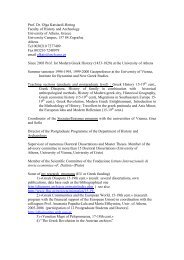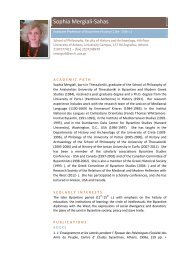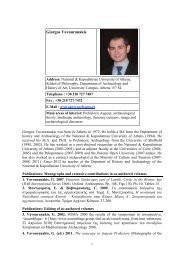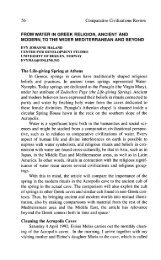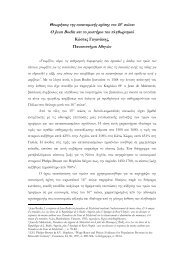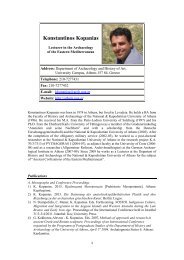The Dormition of the Virgin Mary on the Island of Tinos: A ...
The Dormition of the Virgin Mary on the Island of Tinos: A ...
The Dormition of the Virgin Mary on the Island of Tinos: A ...
You also want an ePaper? Increase the reach of your titles
YUMPU automatically turns print PDFs into web optimized ePapers that Google loves.
110 JOURNAL OF RELIGIOUS HISTORY<br />
Figure 10 Saluting sailors in uniform, holding <str<strong>on</strong>g>the</str<strong>on</strong>g> ic<strong>on</strong> depicting <str<strong>on</strong>g>the</str<strong>on</strong>g> Annunciati<strong>on</strong> <str<strong>on</strong>g>of</str<strong>on</strong>g> <str<strong>on</strong>g>the</str<strong>on</strong>g><br />
<str<strong>on</strong>g>Virgin</str<strong>on</strong>g> during <str<strong>on</strong>g>the</str<strong>on</strong>g> cerem<strong>on</strong>y at <str<strong>on</strong>g>the</str<strong>on</strong>g> harbour. (Author’s photograph.)<br />
<str<strong>on</strong>g>of</str<strong>on</strong>g> <str<strong>on</strong>g>the</str<strong>on</strong>g> important mediating positi<strong>on</strong> <str<strong>on</strong>g>of</str<strong>on</strong>g> a mo<str<strong>on</strong>g>the</str<strong>on</strong>g>r. <str<strong>on</strong>g>The</str<strong>on</strong>g> Panagia is also called<br />
Mesitria, <str<strong>on</strong>g>the</str<strong>on</strong>g> mediator. She is essentially a human intercessor and a mo<str<strong>on</strong>g>the</str<strong>on</strong>g>r, and<br />
her maternal role is emphasized within <str<strong>on</strong>g>the</str<strong>on</strong>g> Orthodox traditi<strong>on</strong>, as well as her<br />
power within <str<strong>on</strong>g>the</str<strong>on</strong>g> heavenly and earthly world.<br />
<str<strong>on</strong>g>The</str<strong>on</strong>g>re are several rituals that women <strong>on</strong>ly can carry out. By focusing <strong>on</strong><br />
<str<strong>on</strong>g>the</str<strong>on</strong>g>se we move from a man’s world to a woman’s world and c<strong>on</strong>sider values and<br />
cults that are important to women. In a broader perspective we realize that <str<strong>on</strong>g>the</str<strong>on</strong>g>se<br />
cults also have importance for <str<strong>on</strong>g>the</str<strong>on</strong>g> <str<strong>on</strong>g>of</str<strong>on</strong>g>ficial ideology.<br />
According to Dubisch: “we must move away from such terms as ‘mo<str<strong>on</strong>g>the</str<strong>on</strong>g>r<br />
worship,’ to which Marian devoti<strong>on</strong> is sometimes reduced, and toward a more<br />
general explorati<strong>on</strong> <str<strong>on</strong>g>of</str<strong>on</strong>g> issues both <str<strong>on</strong>g>of</str<strong>on</strong>g> political ritual and symbol and <str<strong>on</strong>g>of</str<strong>on</strong>g> <str<strong>on</strong>g>the</str<strong>on</strong>g><br />
symbolism <str<strong>on</strong>g>of</str<strong>on</strong>g> <str<strong>on</strong>g>the</str<strong>on</strong>g> feminine.” 44 Generally, <str<strong>on</strong>g>Mary</str<strong>on</strong>g> presents a dilemma for American<br />
and Western-European feminists, a fact Dubisch recognizes. Although <strong>on</strong>e<br />
may claim that Dubisch argues for a c<strong>on</strong>textualizati<strong>on</strong> <str<strong>on</strong>g>of</str<strong>on</strong>g> Marian devoti<strong>on</strong>,<br />
<str<strong>on</strong>g>the</str<strong>on</strong>g>reby moving bey<strong>on</strong>d describing this devoti<strong>on</strong> in terms <str<strong>on</strong>g>of</str<strong>on</strong>g> mere “mo<str<strong>on</strong>g>the</str<strong>on</strong>g>r<br />
worship,” which results in an enrichment instead <str<strong>on</strong>g>of</str<strong>on</strong>g> a reducti<strong>on</strong> <str<strong>on</strong>g>of</str<strong>on</strong>g> terms like<br />
<str<strong>on</strong>g>the</str<strong>on</strong>g>se, I do not agree with her critique, since “mo<str<strong>on</strong>g>the</str<strong>on</strong>g>r worship” generally and<br />
44. Dubisch, In a Different Place, 246.<br />
© 2012 <str<strong>on</strong>g>The</str<strong>on</strong>g> Author<br />
Journal <str<strong>on</strong>g>of</str<strong>on</strong>g> Religious History © 2012 Religious History Associati<strong>on</strong>





